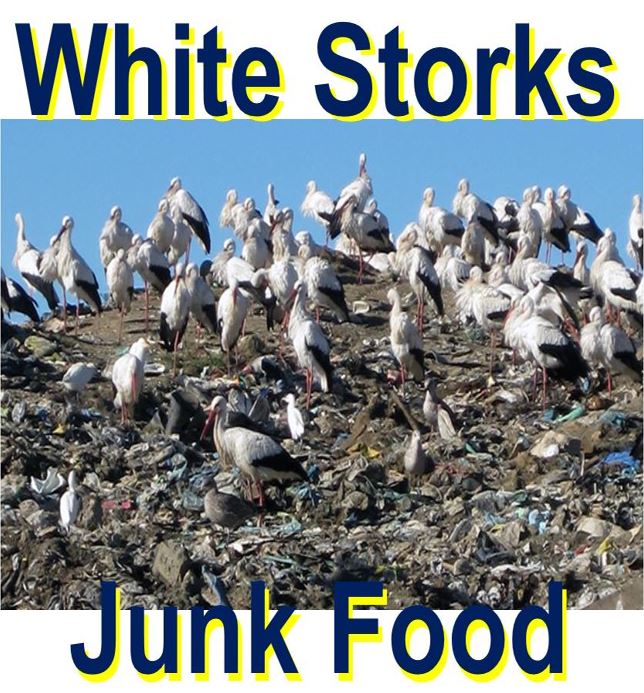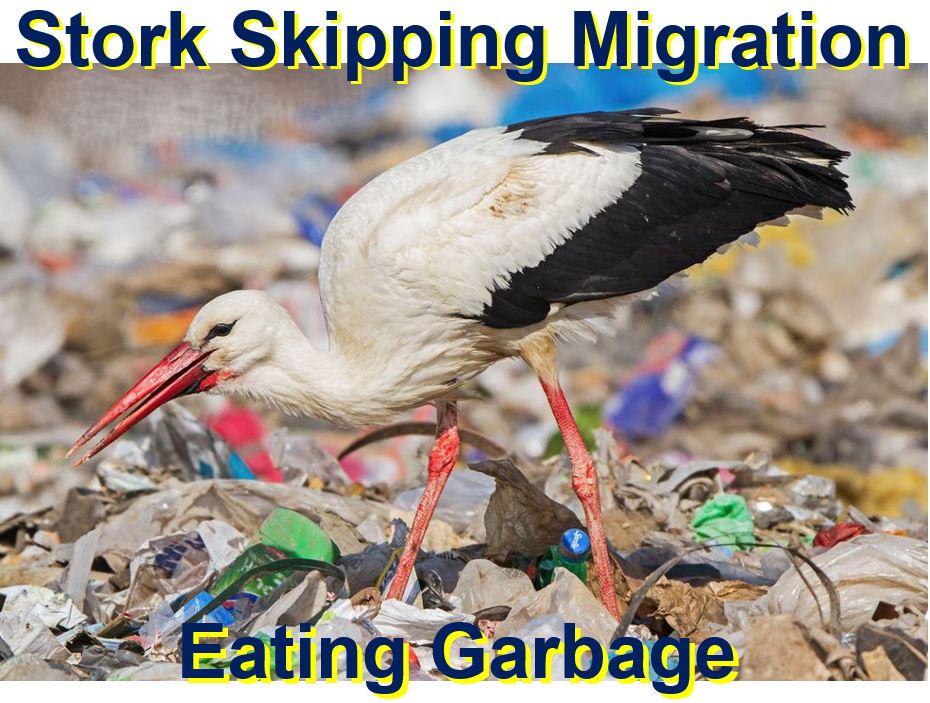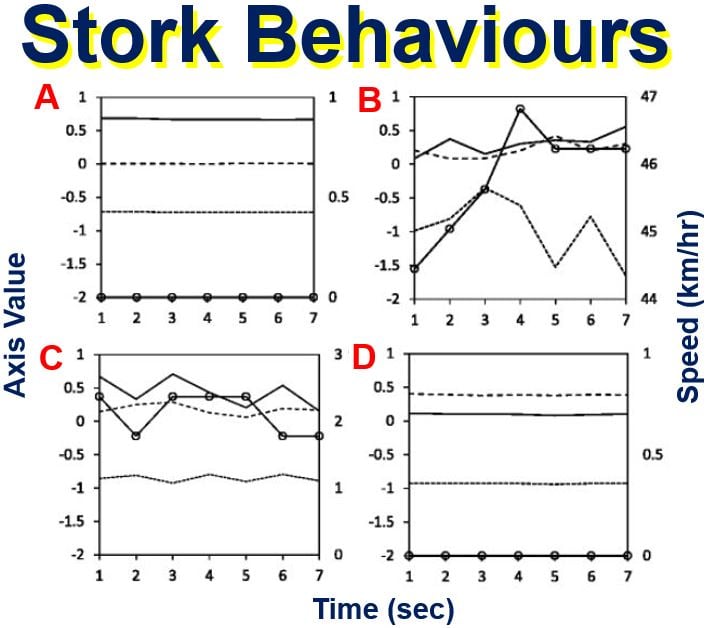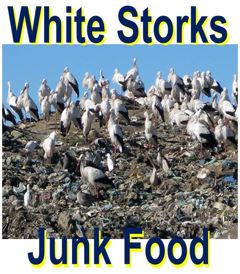White storks love junk food so much that they have stopped migrating – they regularly make 100-kilometre round trips to get their rubbish-tip fix, say scientists from the University of East Anglia in England. There is concern that when these landfill sites are closed down – something that is about to happen in the European Union – these birds will suffer.
In European folklore, white storks (Ciconia ciconia) bring little babies down chimney chutes. Hans Christian Anderson wove this folklore into – The Storks – his 1838 fairy tale. The Stork-and-Baby story has been an alternative to the Birds-&-Bees explanation for centuries.
Since the mid-1980s, a new story has developed – an ever-growing number of white storks are no longer migrating from Europe to Africa for the winter. That story, however, is a true one.
 According to the British Trust for Ornithology, white storks no longer all fly to Africa to winter. They are now a common sight on landfill sites in Portugal and Spain in winter. (Image: uea.ac.uk)
According to the British Trust for Ornithology, white storks no longer all fly to Africa to winter. They are now a common sight on landfill sites in Portugal and Spain in winter. (Image: uea.ac.uk)
Many storks not flying to Africa
A large proportion of the white stork population in Portugal and Spain stay put the whole year round. They get their nourishment – ‘junk food’ – from landfill sites, which provide lots for them to eat.
Some of the storks that winter in Portugal are from breeding populations in Central and Eastern Europe – they are no longer flying all the way down to Africa.
C. ciconia is among a growing number of migratory birds that have altered their behaviour due to global environmental change and human influences.
New research published in the journal Movement Ecology is the first to confirm that white storks are currently resident nesting and living close to rubbish tips all year round.
![]() (Top) A stripped down GPS/GSM tracking device. (Bottom) A white stork with a tracking device on its back. (Top image: bto.org. Bottom: uea.ac.uk)
(Top) A stripped down GPS/GSM tracking device. (Bottom) A white stork with a tracking device on its back. (Top image: bto.org. Bottom: uea.ac.uk)
An EU Landfill Directive requires that landfill sites close, a move that could have a dramatic impact on white stork populations, the researchers warn.
Junk food influences many stork behaviours
Study leader, Dr. Aldina Franco, who works at UEA’s School of Environmental Sciences, said:
“Portugal’s stork population has grown 10 fold over the last 20 years. The country is now home to around 14,000 wintering birds, and numbers continue to grow. These are exciting times to study animal migration. Several species, including the white stork, which used to be fully migratory in Europe now have resident populations.”
“We want to understand the causes and the mechanisms behind these changes in migratory behaviour. This study looked at the birds’ reliance on landfill food, we found that the continuous availability of junk food from landfill has influenced nest use, daily travel distances, and foraging ranges.”
Dr. Franco and colleagues tracked forty-eight storks using GPS tracking devices which transmit their positions five times per day. The trackers also collected accelerometer data with detailed information about the birds’ behaviour. An accelerometer is an instrument for measuring the acceleration of a moving or vibrating body.
The research team is also developing these trackers at UEA together with colleagues from the British Trust for Ornithology and the University of Lisbon.
 According to America’s National Audubon Society: ” In recent years, more and more White Storks are choosing to stay closer to home and scrounge for easy pickings in landfills and fish farms.” (audubon.org)
According to America’s National Audubon Society: ” In recent years, more and more White Storks are choosing to stay closer to home and scrounge for easy pickings in landfills and fish farms.” (audubon.org)
The data from the trackers allowed the researchers to monitor the storks’ movement between nesting and feeding areas, determine how many long and short distance flights they were doing, and study their behaviour – to see whether they were foraging for food, standing and preening, or looking after their eggs.
Junk food means storks can stay put
Storks depend on landfill sites today for food, the authors wrote, especially during the non-breeding season when there is less natural food about. Junk food has made it possible for them to stay put all year round.
Dr. Franco said:
“We found that the landfill sites enable year-round nest use, which is an entirely new behaviour that has developed very recently. This strategy enables the resident birds to select the best nest sites and to start breeding earlier.”
“Having a nest close to a guaranteed food supply also means that the storks are less inclined to leave for the winter. They instead spend their non-breeding season defending their highly desirable nest locations.”
 White stork behaviours identified using the accelerometer data: A inactive (standing up), B flight, D foraging, D tending eggs. The three axes and speed are represented, X axis- surge (black line), y axis -sway (dashed line), z axis -heave (dotted line) and speed (line with circles). (Image: Movement Ecology Journal)
White stork behaviours identified using the accelerometer data: A inactive (standing up), B flight, D foraging, D tending eggs. The three axes and speed are represented, X axis- surge (black line), y axis -sway (dashed line), z axis -heave (dotted line) and speed (line with circles). (Image: Movement Ecology Journal)
“But we also show that as well as those nesting close to the landfill sites, others are willing to travel up to 48.2km to visit landfill sites during the non-breeding season and up to 28.1km during the breeding season. This is much further than previous estimates.”
“Under new EU Landfill Directives, rubbish dumps sites in Portugal are scheduled to be gradually replaced by new facilities where food waste is handled under cover. This will cause a problem for the storks as they will have to find an alternative winter food supply. It may well impact on their distribution, breeding location, chick fledging success and migratory decisions.”
This latest study forms part of Nathalie Gilbert’s PhD project funded by the NERC (Natural Environmental Research Council), with the British Trust for Ornithology as a CASE partner. The PhD supervisor is Dr. Franco.
Previous study – similar findings
In January 2016, the Max Planck Institute for Ornithology in Germany reported that storks were either not migrating at all or flying significantly shorter distances than they used to. The bird conserves energy by remaining in places made by humans with abundant food, such as landfill sites and fish farms.
This study also found that many white storks spend the winter feeding on local garbage rather than migrating. In fact, those that remain behind (do not migrate) are more likely to survive, they found.
Study leader, Dr. Andrea Flack, a postdoctoral researcher, said:
“Those that stay north of the Sahara seem to have advantages from feeding on these landfill sites in Morocco. For a white stork it’s a good place; they find a lot of food there. But of course it’s a risk; one wrong food and they’re dead.”
Citation: “Are white storks addicted to junk food? Impacts of landfill use on the movement and behaviour of resident white storks (Ciconia ciconia) from a partially migratory population,” Nathalie I. GilbertEmail author, Ricardo A. Correia, João Paulo Silva, Carlos Pacheco, Inês Catry, Philip W. Atkinson, Jenny A. Gill and Aldina M. A. Franco. Movement Ecology. 15 March 2016. DOI: 10.1186/s40462-016-0070-0.
BBC Video – Storks and junk food
Since the 1980s, a population of white storks in Portugal has skipped migration, because they can get all the food they require from open landfill sites in the south of the country.

